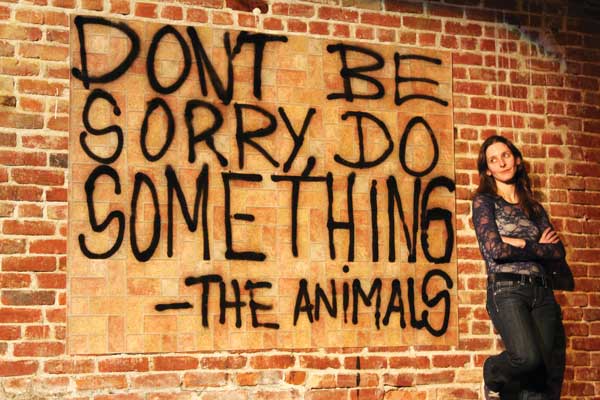
FringeNYC shows by, or about, Villagers
BY SCOTT STIFFLER | They play up its global identity right there in the title — yet of the nearly 200 shows that are part of the New York International Fringe Festival, well over a dozen either take place in the Village or were created by Villagers.
That makes this edition of the annual theater fest an unusually hyperlocal one, in which more than a few shows are being performed within blocks of their actual settings…often by a cast who came to the Village from far-off places, only to find themselves acting in a show about…the Village. Confused? Intrigued? Filled with local pride? Don’t be…except for that last one. This should clear things up a bit:
I’M SORRY
Written & Performed by Katya Lidsky
Directed by Giles Chiasson
Sat., Aug. 18, 9pm; Sun., Aug. 19, 7:15pm; Wed., Aug. 22, 6:30pm; Fri., Aug. 24, 5pm; Sat., Aug. 25, 9:15pm; Sun., Aug. 26, 2pm
At The White Box at 440 Studios (440 Lafayette St., Astor Place)
Tickets: $15 in advance
$18 at the box office
To order, and for a full schedule of FringeNYC events, visit fringenyc.org
In our recent phone conversation (not her one call from jail), Katya Lidsky didn’t seem like the troublemaking type at all. So how did this nice Cuban-Jewish girl end up cooling her heels in a West Village holding cell?
Originally from Laredo, TX and currently based in L.A., Lidsky did four years of hard time as an undergrad at NYU. Inspired by her lingering affection for the West Village, “I’m Sorry” is set in Manhattan and concerns, as Lidsky tells it, “an overly apologetic person who has experiences that change her. She becomes an animal activist, which is not a people-pleasing stance to take.”
The culminating scene of this solo show, in which Lidsky plays 16 men, women and animals, takes place at the Sixth Precinct — after the formerly meek main character blossoms into a rebel with a cause.
“It’s based on my life,” says the writer/performer. “Almost all of the events are true. I wanted to tell it because I’m hoping other people-pleasers might find a sense of purpose, which for me, saved my butt…to know you have something greater than yourself to focus on.”
Caged in her West Village holding cell, like an animal, Lidsky says her formerly mousy alter ego “stops apologizing and realizes she is not sorry. If people don’t like her, that’s too bad. It’s her new attitude, and that’s the new life she’s going to lead.”
Lidsky is not afraid of biting the hand of the locale that fed the show its subject matter and setting. “I spent a lot of time in the West Village when I went to NYU,” she recalls. “It’s so progressive. But I’m shocked,” she says referencing puppy mills and unethical breeders, “that there are over six pet stores [in the area] that sell their puppies. I don’t mean to attack West Villagers, but I chose to focus on this area because it’s such a sweet spot for change. It’s a great model for what I think New York City can do for animals.”
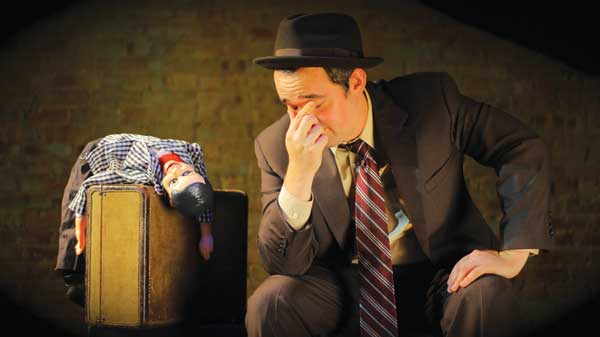
AFTER THE CIRCUIT
Written & Produced Josh Billig
Directed by Matthew Singletary
Sat., Aug 18, 7:15pm and
Sat., Aug. 25, 12pm
At The Connelly Theater (220 E. 4th St., btw. Aves. A & B)
Visit afterthecircuit.com
It’s 1933 — and while the Great Depression hasn’t even begun to ebb, vaudeville’s been on the wane for the better part of a decade. The once-vibrant theaters of the Lower East Side have either shuttered or replaced their stages with movie screens — forcing plate spinners, tap dancers, comedy teams and their ilk to spread out across the country. Unlike Buster Keaton or The Marx Brothers, few would find steady work in Hollywood (or anywhere else).
Following the morphine overdose of his twin brother and performing partner, rudderless Theo must prevent his marriage, and career, from crumbling.
“The protagonist is trying to figure out how he can be a vaudevillian without his partner, and in a world where vaudeville is getting smaller and smaller,” says playwright Josh Billig, who set much of the action “in the tenement where my great grandfather grew up, on East Fourth and Avenue C. The family lived there from around 1902-1925. It was this generation of immigrants that influenced vaudeville and comedy. So many of these great vaudevillians took to the road and spread their style of humor from New York to California.”
Although they weren’t in show business, Billig did draw inspiration from his family’s time as tenement dwellers, noting parallels between vaudeville performers and East Village residents. “That area,” Billig says, “had a huge immigrant population. You had this melting pot of Jewish, Italian, Irish. It was this really bizarre sense of community where it was insulated within itself. So whatever clan you came from, you’d be that first. Then of your neighborhood, then of New York. I think that’s kind of gone now…but maybe it’s morphed into something else. You still have tenements, but they’re called ‘projects.’ You still find these close knit communities, similar to what was happening in ’20s and ’30s.”
Billig also draws parallels to 2012 and the era of his play, in the hard times experienced by performers displaced from their chosen mediums. “In the same way that movies killed vaudeville,” he laments, “the Internet is doing that to so many of the arts, be it film or TV or theater. They still exist, and I think they will always exist. But at the same time, with the ubiquity of YouTube, it makes it hard for an artist to be an individual and find their niche.”
Good to know, then, that the resilient Billig has managed to bend YouTube to his own will by posting a vaudeville skit from “After the Circuit.” But if you want to access it, please: Find your way there by visiting afterthecircuit.com instead of proceeding directly to that infamous Internet site whose name we won’t mention again. Theater may embrace the synergy, but it doesn’t need the competition.
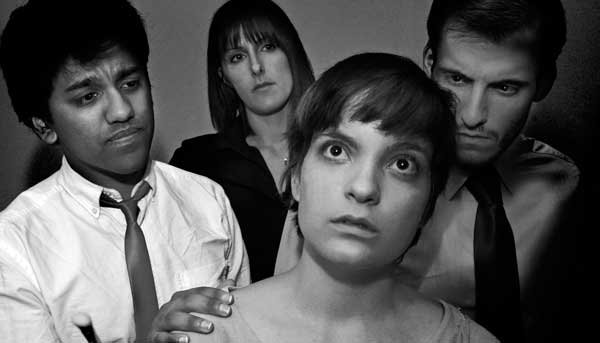
OTHER FringeNYC SHOWS SET IN THE VILLAGE
Much of “The Girl with Her Hands in the Sand” takes place in an East Village art studio. After the death of her mother, a young artist on the verge becomes obsessed with her work. But what happens when the paint starts to run dry, and reality starts to set in? Playwright Jonathan G. Galvez describes “Girl” as “a very New York play” about “an artist living Downtown as opposed to Uptown, where her sister lives. There’s this physical and ideological difference between them. Downtown, you feel like you have a little more freedom, and live by your wits. Uptown feels more structured.”
“Scarlett Fever” is a “pop culture-infused comedy” in which Joey and her best friend Gracie (a Scarlett Johansson superfan) live in the East Village while plotting their entrance into New York’s world of the rich and famous.
Bi-coastal playwright Dani Vetere, who’s been a Village resident for over a decade, penned “Hadrian’s Wall.” Set in the West Village, it involves “Ramona, a reclusive archaeologist with a tarnished reputation who meets a younger woman determined to uncover more than just the truth. Two girls, one guy and a dinosaur.”
“Best Night Ever,” which takes place in the East Village, has Chelsea resident and Tony nominee Lou Liberatore as a guy whose “chance encounter at a trendy bar spirals into a dangerous game of sex and deceit.”
“In Heat: Is She Hot Under Her Collar or Under Her Skirt?” star Doris Anderson plays a Gender-Queer revolutionary who dispenses dating tips and makes the case for cat neutering — all from the confines of her headquarters, located off an alley on Avenue C.
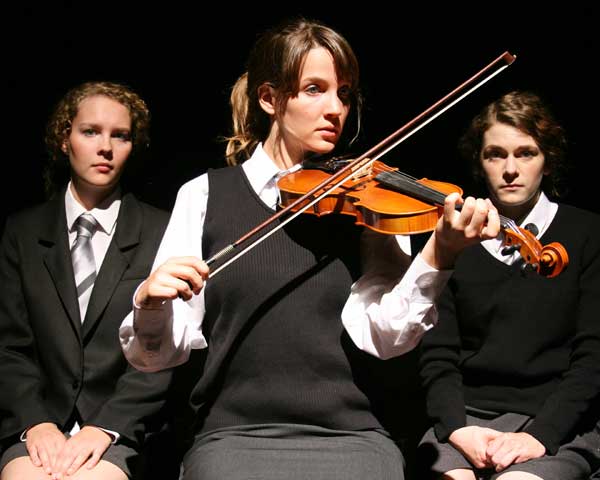
FringeNYC SHOWS CREATED BY, OR FEATURING, VILLAGERS
In “Canon in D Minor,” West Village resident and former star of Broadway’s “Spring Awakening” Eryn Murman stars as Beth — who, after the suicide of her best friend, “glides the bow of her violin through the music that connected them in this tender and poetic story of friendship and forgiveness.”
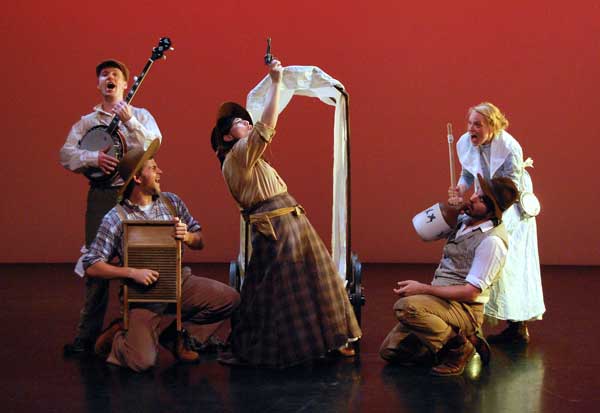
West Village resident Ryan Emmons co-authored (and directs) “Quest for the West: Adventures on the Oregon Trail.” This interactive musical transports the audience back to 1848 — then takes them on a 2,000-mile wagon train journey.
Tara Schuster, also a West Village resident, wrote “I <3 Revolution” — in which she and two other equally incompetent revolutionaries kidnap the audience and force them to attend a workshop where the graduates will emerge with a knowledge of extremist political tactics as well as the necessary skills for determining their perfect dress shape.
Sam Byron, who lives in the East Village, wrote “Animals” — about “a group of twenty-somethings kicking around their suburban hometown. Some got out, some stayed, and some were held captive, but they must all confront the unexpected violence that lives inside them.”
Also an East Villager, Crystal Finn is the writer and performer of “Becoming Liv Ullmann.” Crystal will do anything to win back Ezra. She’ll even “become a Swedish movie star” — and she does, in this tribute to love, madness and Bergman’s “The Seventh Seal.”
For a full schedule of performances, visit fringenyc.org.

















